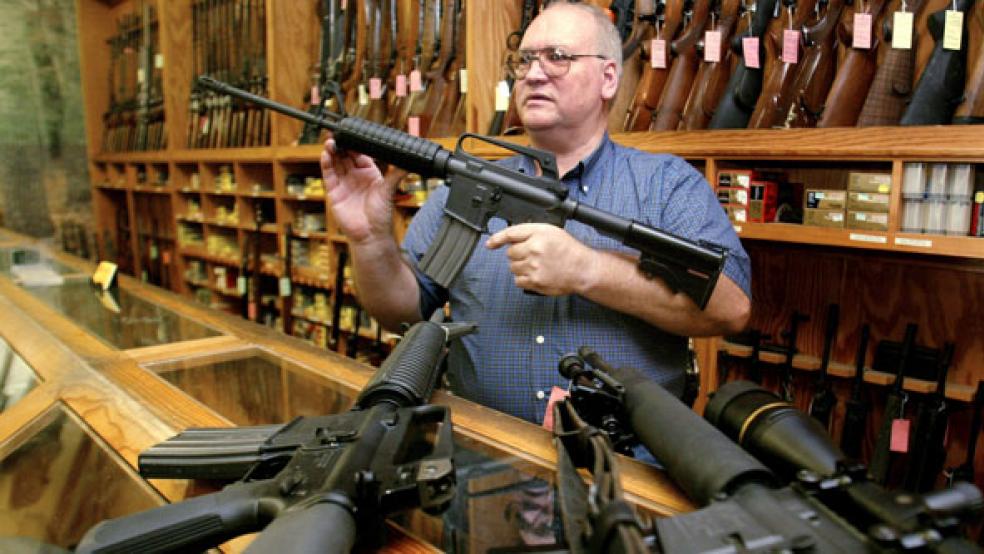States with higher estimated rates of gun ownership experience a higher number of firearms-related homicides, according to new research. The study, published in the American Journal of Public Heath, examines the National Rifle Association’s (NRA) claim that increased gun ownership does not lead to increased gun violence.
It is the largest study conducted to date into the correlation between gun ownership and firearms violence, and the first to comprehensively examine the issue since the tragic shooting last December of 20 children and 7 adults at Sandy Hook Elementary School in Newtown, Connecticut.
RELATED: 19 UNBELIEVABLE FACTS ABOUT GUNS IN AMERICA
Covering 30 years (1981-2010) in all 50 states, the report shows a “robust correlation” between estimated levels of gun ownership and actual gun homicides at the state level, even when controlling for factors typically associated with homicides. For each 1 percentage point increase in the prevalence of gun ownership, the state firearm homicide rate increases by 0.9 percent, the authors found.
“Understanding the relationship between the prevalence of gun ownership and therefore the availability of guns, and firearm-related mortality is critical to guiding decisions regarding recently proposed measures to address firearm violence,” the study authors say.
RELATED: GUNMEN OPENED FIRE AT NAVY YARD IN WASHINGTON; SEVERAL KILLED
Researchers led by Michael Siegel, professor of community health sciences at the Boston University School of Public Health, examined data for the years 1981-2010 on state firearm homicide rates from the Center for Disease Control and Prevention’s Web-Based Injury Statistics Query and Reporting System (WISQUARS) database.
HOW THE ANALYSIS WAS CONDUCTED
State levels of gun ownership were estimated using a well-established proxy variable: the percentage of a state’s suicides that are committed with a firearm (FS/S). Because there is no state-level survey that measures household gun ownership, researchers have widely relied upon the FS/S proxy in injury prevention research, and this proxy has been extensively validated in past studies. The proxy correlates highly with survey measures of household firearm ownership, the authors say.
The researchers used regression analysis to examine the relationship between state levels of gun ownership and firearm homicide rates, while controlling for a range of potential state-level confounding variables, including: age, gender, race/ethnicity, urbanization, poverty, unemployment, income, education, divorce rate, alcohol use, violent crime rate, nonviolent crime rate, number of hunting licenses, age-adjusted non-firearm homicide rate, incarceration rate, and suicide rate.
The regression model predicted that each 1 percentage point increase in gun ownership increases a state’s firearm homicide rate by 0.9 percent, translating into a 12.9 percent increase in the gun homicide rate for each one standard deviation increase in gun ownership. All other factors being equal, for example, the model predicts that if the gun ownership estimate for Mississippi were 58 percent (the average for all states), instead of 77 percent (the highest of all states), its firearm homicide rate would be 17 percent lower.
The results of the research are consistent with previous studies that have demonstrated a correlation between higher levels of gun ownership and higher levels of firearm homicide.
PUBLIC POLICY IMPLICATIONS?
Siegel notes that the study did not determine causation, allowing that it is theoretically possible that people are more likely to purchase guns if they live in states with higher levels of firearm homicide. But he says the issue warrants further study.
RELATED: HOW RAISING TAXES ON GUNS COULD REDUCE VIOLENCE
“In the wake of the tragic shooting in Newtown, Connecticut, last year, many states are considering legislation to control firearm-related deaths. This research is the strongest to date to document that states with higher levels of gun ownership have disproportionately large numbers of deaths from firearm-related homicides.
“It suggests that measures which succeed in decreasing the overall prevalence of guns will lower firearm homicide rates,” he says.
STATE BY STATE
The new study is the first cross-sectional analysis to examine data more recent than 1999 and is the most comprehensive to date, both in the number of years studied and the breadth of variables that were controlled for in the analysis. The study found that over the three decades, the mean estimated percentage of gun ownership ranged from a low of 25.8 percent in Hawaii to a high of 76.8 percent in Mississippi, with an average over all states of 57.7 percent.
The mean age-adjusted firearm homicide rate ranged from a low of 0.9 per 100,000 population in New Hampshire to a high of 10.8 per 100,000 in Louisiana over the three decades, with an average for all states of 4 per 100,000.
For all states, the average firearm homicide rate decreased from 5.2 per 100,000 in 1981 to 3.5 per 100,000 in 2010.
Co-authors on the study include Craig Ross of Virtual Media Resources and Charles King III of Pleiades Consulting Group.
This article originally appeared in Futurity.org. Source: Boston University.




